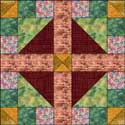

| Presser Foot: darning foot | Stitch Setting: straight |
| Top & bobbin threads: a good quality thread of cotton, polyester, rayon can be used (use same color thread in the top and bobbin so you don't see thread dots on the top or back of your finished quilt |
Stitch Length: not applicable The stitch length is controlled by the slow or fast movement of your hands and the pressure of the foot on the machine foot pedal. Hardly any movement of hands and fast speed = too small of stitches Too fast hands with slow speed = too large of stitches Slow hand with med. to fast speed = good consistent stitches |
| Needle:size 80/12 sharp embroidery needle | Stitch Width: 0 |
| Needle Position: centered | Feed Dogs: lowered |
| Top Tension: normal for your machine (adjust by sewing on a test sample) Tension at 4 is a good starting point |